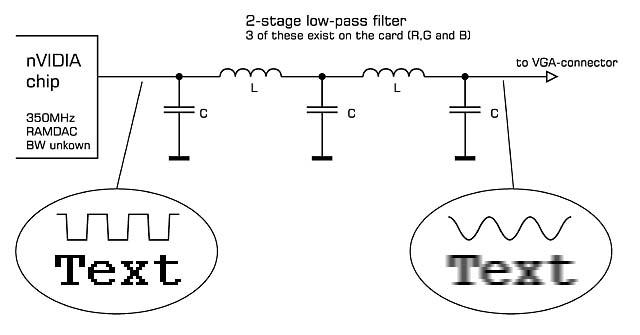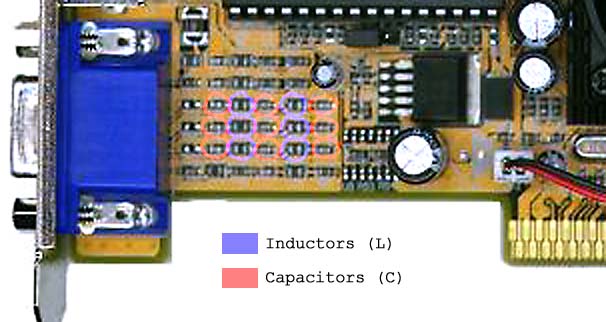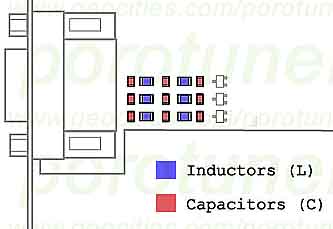| Many (or all?)
nVIDIA GeForce and TNT -based cards have the above circuit onboard.
It is a low pass filter and it's purpose is to reduce RFI emissions.
In many cases it's manufactured with low quality components and
/ or designed badly. If 'misdesigned' it basically stops most of
the high frequency information necessary to produce, for example,
sharp text at high resolutions and refresh rates.
To produce decently
sharp image at 1600x1200@75Hz you need at least 150MHz of videobandwidth.
That is half of the pixelclock frequency, called also as RAMDAC
speed. However, on some videocards the RF filter on the VGA outputs
(diagram above) is designed so that it restricts the videobandwidth
to even as low as 60...70MHz. This is unacceptable because these
videocards, in case of GeForce2 GTS / MX, are advertised to have
350MHz RAMDACs and capable of resolutions of 2048x1536 at refresh
rate of 75Hz.
|
You can use this table as a guideline what should be possible
with you monitor and videocard. These numbers are approximate
only, they may vary ±10% depending on operating system and the
videocard used.
The videobandwidth of your monitor is often found in the
technical specifications part of your monitors manual.
Videobandwidth of a videocard is generally not told to
the public - because it would tell the customer too much about
the real quality of the product, and that is something the marketing
people don't like us to know... You should except that a videocard
has bandwidth something near half of the maximimum RAMDAC frequency. |
| Resolution |
Refresh
Rate |
Video
Bandwidth |
RAMDAC
clock |
| 800x600 |
75Hz |
40MHz |
80MHz |
| 800x600 |
85Hz |
45MHz |
90MHz |
| 800x600 |
100Hz |
50MHz |
100MHz |
| 1024x768 |
75Hz |
60MHz |
120MHz |
| 1024x768 |
85Hz |
70MHz |
140MHz |
| 1024x768 |
100Hz |
80MHz |
160MHz |
| 1280x1024 |
75Hz |
100MHz |
200MHz |
| 1280x1024 |
85Hz |
115MHz |
230MHz |
| 1280x1024 |
100Hz |
130MHz |
260MHz |
| 1600x1200 |
75Hz |
145MHz |
290MHz |
| 1600x1200 |
85Hz |
165MHz |
330MHz |
|
If
you have a blurry image on resolutions that should be crystal clear
on your monitor:
Check that your
monitor has enough videobandwidth
Make sure your
vga cable is sufficiently high quality
Test the system
without any additional devices on the vga cable -- connect the
cable from your monitor directly to your videocard
If possible,
verify that your monitor and cabling is up to task by trying some
other videocard that is known to have sharp picture quality (matrox
G200/G400 for example)
|
| If
according to these tests the cause of blurriness is the nVIDIA -based
videocard I advice you to return it, or at least complaint about
it, to the manufacturer.
The following
contains some guidelines for fixing the problem yourself by modifying
the videocard.
|
 The
Fix The
Fix |
Prolink Pixelview GeForce 2 MX
| Please
read this through also in case of other cards, it contains
some necessary information. |
|
GeForce2 MX nVIDIA reference based
boards.
These
include: Asus V7100, Gainward CardExpert GeForce2 MX,
Leadtek Winfast GeForce2 MX, Sparkle SP6800 GeForce2
MX and many others.
Elsa Gladiac MX has also similar filter configuration. |
|
GeForce2 GTS nVIDIA reference based
boards.
| These
include: Asus V7700, Chaintech GeForce2 GTS 64MB, Creative
Labs 3D Blaster Annihilator 2, Elsa Gladiac GeForce2
GTS, Guillemot Hercules 3D Prophet II, Leadtek WinFast
GeForce2 GTS, MagicPro GeForce2 GTS 64MB and many others. |
|
Hercules 3D Prophet II MX
| This
one differs a bit from the reference design, but can
be modified as well. |
|
|
| WARNING
: the following contains instructions to modify low-pass filtering
of some videocards. This requires soldering of Surface Mount
Devices. If you haven't done SMD-work before don't practice
with your videocard - the lessons might be expensive! Have
an experienced person to do it for you with correct equipment
if you have the slightest doubt about this.. or don't do it
all.. Modifying your videocard may destroy it and void any
warranties. Modified videocard may also cause radio frequency
interference (RFI) exceeding your local regulations. I take
no responsibility of any damage caused. |
|
|
| Prolink
Pixelview GeForce 2 MX |
| Below you see a
closeup near the VGA connector of the Prolink Pixelview GeForce
2 MX. This card, in my experience, suffers very badly about image
blurriness above 1024x768@75Hz, which is equivalent of videobandwidth
of only ~65MHz. The card (like any other MX card) has a 350MHz RAMDAC,
requiring at least 175MHz of video BW to usable sharp image quality
on all supported resolutions.
Many users have
experienced similar problems, in varying degree, also with other
GF2MX cards like Asus7100, Elsa Gladiac MX, Hercules Prophet II
MX and so on. GeForce 2 GTS cards generally have better videobandwidth
than the GF2MX ones, but this fix will most likely improve also
the image quality of GTS-cards, at least in resolutions of 1600x1200
and up.
|
|
| The videobandwidth
is limited by the components indicated in above image. Removing
the capacitors, marked with red, and shorting the inductors (soldering
a piece of wire between the ends), marked with blue will disable
this filter totally. Doing so improved image quality dramatically
in my case. I left the rightmost capacitors in place (3 of them)
.. removing them may improve the picture in the case of long monitor
cabling.
The part numbers
on this card are:
1st row: C84, L10, C85, L11, C86
2nd row: C101, L12, C102, L13, C103
3rd row: C111, L14, C112, L15, C113
|
| I removed C84,
C101, C111, C85, C102, C112 and shorted L10, L12, L14, L11, L13,
L15 and left C86, C103, C113 in place. With this modification the
videobandwidth, estimated visually on monitor, is at least over
120MHz giving a sharp image at 1280x1024@85Hz. I Can't test any
higher because my monitor is the limiting factor above this but
I guess that 1600x1200@75Hz should not be bad (It would require
VideoBW around 145MHz). This mod caused no RFI problems for me.
I have a radio (with antenna), a TV/VCR set and image scanners under
2 meters distance from the computer and they all work as well as
before.
addenum: I've
also removed the rest of those capacitors, resulting significant
image quality improvement at high resolutions such as 1280x1024@85Hz.
|
| If you like to
try the mod in phases do the following, testing the card for image
quality between each stage:
remove
C84, C101, C11
short
L10, L12, L14
remove
C85, C102, C112
short
L11, L13, L15
remove
C86, C103, C113
|
Or
if you like to tryout a quick test: Use 3 wires, as short as possible,
to connect
leftmost
pad of L10 to rightmost pad of L11
leftmost
pad of L12 to rightmost pad of L13
leftmost
pad of L14 to rightmost pad of L15
After this you can go on by removing C84, C101, C111 and then
C86, C103, C113. And if you wan't, also C85, C102 and C112. If
you _really_ don't like to remove any components from your videocard
it is quite safe to leave all the capacitors in place.
Some people
tell me they have had success also using conductive paint to
short these inductors. Just put a layer of that on top of the
inductor so it covers the soldering areas of the inductor at
both ends.
Shorting the
inductors will skip the filter, but the capacitive loading on
the RAMDAC output will be higher - that will most likely continue
to have some negative effect on image quality.
Note that the
modification is not nearly as effective if the capacitors are
left in place compared to that they are removed.
If all of the 9 capacitors are removed and the inductors left
untouched the image quality will most likely to be much better
compared to just shorting the inductors and leaving the capacitors
in place.
|
| Other GF2 MX -cards
(and even other nNVIDIA based cards) are often quite similar to
this one. The parts to modify might not be exactly on the same location,
but a skilled person should find them easily...
Note: The really
correct way to do this mod should be to find new component values
for the L and C of the filter in order to make it cut-off frequencies
just above the videobandwidth you will use. This would maximize
the image quality and give lowest possible RFI. They should have
done so already in the factory....
If you are really
into hardware modifications, you can convert this card into a
Quadro2 MXR, See here
or here
|
|




![]()